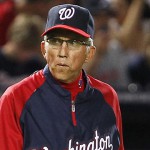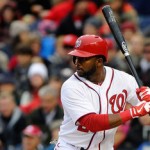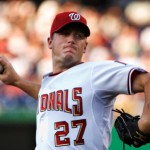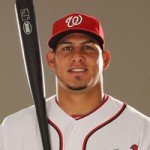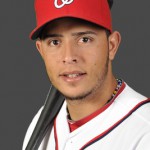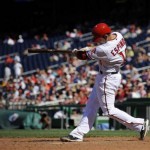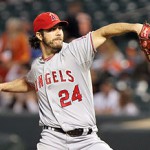2013 DC-Internet Baseball Writers Association
POST-SEASON ACHIEVEMENT AWARDS BALLOT
| AWARD | FIRST (5 POINTS) | SECOND (3 points) | THIRD (1 point) | |
| Goose Goslin Most Valuable PlayerPlayer most valuable to the success of the Washington Nationals | Werth | Desmond | Harper | |
| Walter Johnson Starting Pitcher of the YearExcellent performance as a starting pitcher | Zimmermann | Strasburg | Gonzalez | |
| Frederick “Firpo” Marberry Relief Pitcher of the YearExcellent performance as a relief pitcher | Clippard | Stammen | Roark | |
| Sam Rice Hitter of the YearExcellence in all-around hitting, situational hitting and baserunning | Desmond | Span | Harper | |
| Frank Howard Slugger of the YearExcellence in power hitting | Werth | Harper | Zimmerman | |
| Joe Judge Defensive Player of the YearExcellence in fielding | Span | Desmond | Espinosa | |
| Mickey Vernon Comeback Player of the YearPlayer who overcame biggest obstacle in the preceding season to contribute on the field | Jordan | Ramos | Werth | |
| Josh Gibson Humanitarian Player of the YearPlayer who meritoriously gave of himself to the community | Zimmerman | |||
| Minor League Player of the YearMinor league player most destined for big league success
|
Jordan
Giolito |
Burns
Cole |
Souza
Godwin |
- Goose Goslin Most Valuable Player: Werth, Desmond, Zimmermann. I went Werth, Desmond and Harper. I don’t like voting pitchers for MVP; they have their own awards
- Walter Johnson Starting Pitcher of the Year: Zimmermann, Strasburg, Gonzalez: Same way I voted. I do like the few side-votes for Roark.
- Frederick “Firpo” Marberry Relief Pitcher of the Year : Clippard, Stammen, Soriano: I voted Clippard, Stammen and then Roark. Honestly I did not think Soriano really did that great a job this year. He had a 0.9 WAR for his $15M salary (with deferred payments). That just doesn’t cut it for me for a high-end closer. I want Craig Kimbrel-esque dominance for that kind of money. Roark on the other hand had a 2.0 bWAR in his limited time on the team.
- Sam Rice Hitter of the Year: Werth, Desmond, Zimmerman. I went Desmond, Span, Harper. I dunno; I guess I got caught up on the definition, which included “baserunning” and “situational” hitting. I think I just plain forgot how good a season Werth had here.
- Frank Howard Slugger of the Year: Werth, Harper, Zimmerman: same way as I voted. Maybe we should have put more thought into it besides just listing the team leaders in homers.
- Joe Judge Defensive Player of the Year: Span, Desmond, Ramos. I went Span, Desmond and Espinosa. Despite how bad his bat was, Espinosa was still awfully good in the field. You always forget about the catchers when rating defenders. I’m guilty here.
- Mickey Vernon Comeback Player of the Year: Ramos, Werth, Ohlendorf. I went Jordan, Ramos and Werth. Remember, Jordan had Tommy John surgery and was buried in high-A to start the season. That’s a heck of a comeback. Fair enough on Ramos after his kidnapping ordeal and his injuries.
- Josh Gibson Humanitarian Player of the Year: Zimmerman, Desmond, Gonzalez. Honestly I only voted for Zimmerman; do the rest of these guys do events? Maybe i’m just unaware of what the rest of the team is doing in the charity world, but clearly Zimmerman’s MS causes is well known.
- Minor League Player of the Year : Giolito, Rendon, Cole: I voted Giolito, Cole and Goodwin, thinking that Rendon was “graduated.” I have two lines of players because I wasn’t sure how to answer the question at first; was it “3 best prospects” or “3 best minor league players THIS season?” Because the answer to the latter question clearly is not the same as the answer to the former question.
Survey Questions
1. Which players on the 40-man roster at the end of the season are least likely to return in 2010?
I said Cedeno, Haren, Ohlendorf, Tracy (which were the top four answers among all the responses) but i’d like to change my mind on Ohlendorf. I think the team is going to tender him and keep him around as a long man, considering that he can’t refuse an option until mid-next year. I also think a couple of these random guys picked up on waivers late in the season (Tyler Robinson and Mauro Gomez) may not stick around for the long haul. These two guys in particular never even got numbers assigned to them.
2. Will the Nats sign Ian Desmond and Jordan Zimmermann to long-term contract extensions before they reach free agency?
I said “Desmond yes, Zimmermann maybe.” Honestly, I feel the team can replace Zimmermann from within and may be better served to flip him for prospects if his price tag gets too high. At some point the Nats are going to have to make tough choices like this (they are not going to be able to give 9-figure deals to everyone on this team who deserves them) in order to maintain their core group and contine to compete. You already have two 9-figure deals, and you have to think that Desmond, Harper and Strasburg are going to merit them. can you have a team with that much top-heavy payroll? Now, if you got Zimmerman for Gonzalez prices (5 yrs $50M or so) then you have yourself a deal.
3. What player was the biggest surprise for the Nats this season?
I went with with Jordan, Roark, Werth. The group went with Roark, Werth, Jordan.
4. Who was the biggest disappointment?
I went with Haren, Span, LaRoche. The group went with Haren, Espinosa, Span. Maybe I didn’t include Espinosa because I already had my doubts on him; frankly he didn’t disappoint me, he met my low expectations for him in 2014.
5. Who is your favorite professional Nats writer?
I went with Mark Zuckerman. The survey results went Kilgore, Comak, Zuckerman and Wagner. Coincidentally bon voyage to Comak, who is leaving The Washington Times Nats beat.
6. Who is your favorite non-professional Nationals writer?
I went with Luigi de Guzman, writer of the blog Natstradamus. He doesn’t write that frequently, but when he does they’re usually thoughtful, well researched opinion pieces. Though that’s no slight to Luke Erickson at Nationalsprospects.com, whose blog I absolutely depend on to write this blog. I also really like Ryan Sullivan‘s NatsGM blog and its focus on prospects. Generally speaking my preference in reading baseball writing on the internet leans towards opinion pieces. I know that lots of blogs out there try to be replacement newspaper writers/beat reporters. That’s not what excites me. I want to see opinion pieces, criticism where criticism is due, etc. Harper Gordek at Nationals Baseball is one that definitely writes opinion pieces and I look forward to his stuff too. Unfortunately a lot of these guys have retired (Steven Biel, Chris Needham in particular were always good for a scathing piece when the team deserved it). I know there’s a couple others out there who write good opinion pieces that i’m forgetting.
Yours truly got one vote! That’s awesome, to whichever fellow blogger voted for me.

